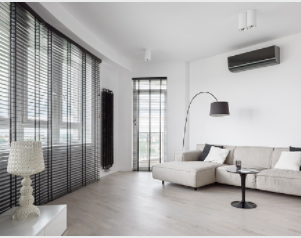Spring is upon us once again, and with it comes the beauty of new Venetian Blinds. The onset of warmer weather often prompts homeowners to let their windows and doors out to allow in the fresh air and take advantage of longer hours of bright sunlight. While this benefits the individual directly, it may not be so great for the structure of your home. A wooden Venetian Blind can warp when left in the damp and hot summer sun. While wood is a natural product, chemicals and treatments used during manufacturing may leach into the wood and harm the surfaces they touch. It makes the use of wooden Venetian Blinds more an option for those interested in privacy control but who are willing to compromise their beauty.
With plastic composite materials, Venetian blinds are made to fit onto any windows, even double-hung windows or sliding glass doors. They provide privacy control by closing over the windows but allow plenty of light and airflow to pass through to keep your home looking nice. Unlike Wooden Venetian Blinds, several types of material from which these excellent window treatments can be made. The first is, of course, wood, but there are also vinyl, polyester, and acrylic varieties. Each provides a different look, but all are excellent at providing privacy as desired.

When selecting colours, one of the best things about Venetian Blinds Adelaide comes in the colours available. You can choose from a massive array of natural wood tones, from light to dark browns, honey tones, to reds and oranges. They are manufactured in virtually any colour you could imagine, including everything from gold and silver to black and white. As with the other window treatments in your home, you can match your wooden blinds to blend perfectly with the rest of your decor.
Another advantage of Venetian Blinds over traditional curtains is that you can open them completely to let in maximum natural light. This way, you can keep your rooms warm during the winter and cool during the summer. While this is an advantage, there are some disadvantages associated with choosing curtains instead. One major disadvantage of curtains is that they can collect dust easily, and because they are open, they can allow some heat in.
There are some additional technical features of Venetian Blinds which provide additional advantages. For example, many of these blinds come with a headrail attached to the bottom rail. The headrail is a safety measure, allowing the person operating the blind to avoid eye injury. However, the headrail can also increase the weight of the blind, causing it to become less practical if you plan to use it for years. Some of these Venetian Blinds are available with removable headrails, allowing you to adjust the weight and fit the blind into any situation.
It is essential to consider the advantages and disadvantages of each of the above features when choosing blinds as window treatments. For example, are you primarily concerned about light control? If so, you should look for blinds that offer the best combination of light control and privacy. The more features a blind has, the more expensive it will be.
